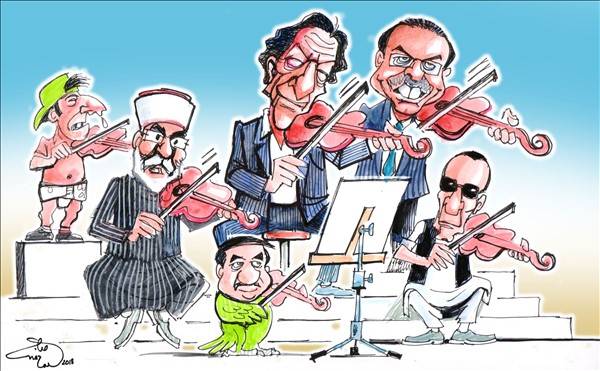
In an extraordinary development, the Balochistan parliament has suddenly packed off a majoritarian chief minister and replaced him with a proxy who secured less than 600 votes in the last general election. It doesn’t take rocket science to uncover the hidden hand that engineered the change at this point of time.
The province is extremely vulnerable on two fronts. It is a front-line region on the western border with Afghanistan from where terrorist and separatist groups continue to foment sectarian violence and target Pakistan’s security apparatus.This accounts for the powerful footprint of the Miltablishment in the province. It is also a hotbed of tribal intrigues, vendettas and opportunism that facilitate manipulation and corruption.
If the strategic importance of the province to the Miltablishment is obvious, so too is its tactical relevance in the current political situation. If the PMLN is to be stopped from improving its position in the Senate so that Nawaz Sharif cannot constitutionally make a comeback, then something must be done to stop the Senate elections from taking place in March before the next general elections are held some months hence. One way to do that is to precipitate a political crisis in which at least two provincial assemblies – Balochistan and Khyber-Pakhtunkhwa – are dissolved, posing a constitutional challenge to holding the Senate elections on time. If necessary, this may be followed by mass resignations from the National Assembly of PTI, PMLQ, PPP, MQM and assorted groups currently in the fold of the Militablishment – including a significant chunk of PMLN “sleepers”— that compels a dissolution of parliament and the installation of an interim federal government cobbled by the Election Commission and Supreme Court of Pakistan. Such an interim government could stretch for months on end until the latest Census results have been collated and constituency delimitation concluded in a “satisfactory” manner. During this period, further political engineering can take place to ensure “suitable” results — a political dispensation that excludes the person of Nawaz Sharif from power (by getting NAB courts to sentence him for corruption) and also denies any political party an outright majority in parliament that might foolishly embolden it to challenge the political hegemony of the Miltablishment, a mistake that both Asif Zardari and Nawaz Sharif respectively made in office and for which they are still paying the price.
If there was any doubt about how this strategy would unfurl after the abrupt change in Balochistan that is primed for action whenever the Miltablishment so wills it, that has ended with the multi-party rally on The Mall in Lahore last Wednesday. Despite a ban on all rallies on The Mall, the Lahore High Court was kind enough to grant an exemption to this fiery “get-together”. Appropriately enough, the evergreen darling of the Miltablishment, Sheikh Rashid, announced his resignation from parliament after abusing it with choice expletives-deleted. As if on cue, Imran Khan held out the threat of the PTI following suit in Islamabad and KP in due course at the “right time”.
The pundits have looked at the sorry state of numbers at the rally and pronounced it a failure. If eighteen parties – including the PTI, PPP and PAT — could not mount even 10,000 protestors, they argue, how on earth are they going to force the governments in Punjab and Islamabad to quit? Indeed, the Sharifs are crowing that those who set out to obtain their resignations have ended up submitting their own!
But this is misplaced concreteness.
The Mall rally was only meant to confirm the pledge of the disparate parties to stand together for the final Heave-Ho when the signal is received rather than immediately go for the Punjab government’s jugular. Balochistan, KP and the opposition parties are now all primed for the coup de grace. They are simply waiting for a nod from the Miltablishment to trigger the beginning of the end of the current political dispensation led by the PMLN.
The “pause” in the internal plan has been necessitated by two factors: a revival of popular sympathy for Nawaz Sharif following his disgraceful “iqama” disqualification that could translate into another win in an early election; and the sudden deterioration of the external situation following President Donald Trump’s unexpectedly aggressive policy tweet against Pakistan’s Miltablishment. It would be foolish to engineer mass political discontent at home in the middle of an external threat that requires the nation to show a united front behind a legitimate government. That is why feverish efforts are underway to dilute the American offensive externally while “going slow” internally.
The Miltablishment is aiming to establish its institutional hegemony on strategic decision making in Pakistan without seizing power directly. The ouster of Nawaz Sharif, the embrace of Shahbaz Sharif, the manipulation of Asif Zardari, the unification of anti-Altaf MQM, the free hand to Imran Khan, the mainstreaming of Jehadi and religious elements to undercut the popular vote, the “disappearances” and media capture, are all steps in this direction. The “civilians” have largely themselves to blame for this denouement.
The province is extremely vulnerable on two fronts. It is a front-line region on the western border with Afghanistan from where terrorist and separatist groups continue to foment sectarian violence and target Pakistan’s security apparatus.This accounts for the powerful footprint of the Miltablishment in the province. It is also a hotbed of tribal intrigues, vendettas and opportunism that facilitate manipulation and corruption.
If the strategic importance of the province to the Miltablishment is obvious, so too is its tactical relevance in the current political situation. If the PMLN is to be stopped from improving its position in the Senate so that Nawaz Sharif cannot constitutionally make a comeback, then something must be done to stop the Senate elections from taking place in March before the next general elections are held some months hence. One way to do that is to precipitate a political crisis in which at least two provincial assemblies – Balochistan and Khyber-Pakhtunkhwa – are dissolved, posing a constitutional challenge to holding the Senate elections on time. If necessary, this may be followed by mass resignations from the National Assembly of PTI, PMLQ, PPP, MQM and assorted groups currently in the fold of the Militablishment – including a significant chunk of PMLN “sleepers”— that compels a dissolution of parliament and the installation of an interim federal government cobbled by the Election Commission and Supreme Court of Pakistan. Such an interim government could stretch for months on end until the latest Census results have been collated and constituency delimitation concluded in a “satisfactory” manner. During this period, further political engineering can take place to ensure “suitable” results — a political dispensation that excludes the person of Nawaz Sharif from power (by getting NAB courts to sentence him for corruption) and also denies any political party an outright majority in parliament that might foolishly embolden it to challenge the political hegemony of the Miltablishment, a mistake that both Asif Zardari and Nawaz Sharif respectively made in office and for which they are still paying the price.
If there was any doubt about how this strategy would unfurl after the abrupt change in Balochistan that is primed for action whenever the Miltablishment so wills it, that has ended with the multi-party rally on The Mall in Lahore last Wednesday. Despite a ban on all rallies on The Mall, the Lahore High Court was kind enough to grant an exemption to this fiery “get-together”. Appropriately enough, the evergreen darling of the Miltablishment, Sheikh Rashid, announced his resignation from parliament after abusing it with choice expletives-deleted. As if on cue, Imran Khan held out the threat of the PTI following suit in Islamabad and KP in due course at the “right time”.
The pundits have looked at the sorry state of numbers at the rally and pronounced it a failure. If eighteen parties – including the PTI, PPP and PAT — could not mount even 10,000 protestors, they argue, how on earth are they going to force the governments in Punjab and Islamabad to quit? Indeed, the Sharifs are crowing that those who set out to obtain their resignations have ended up submitting their own!
But this is misplaced concreteness.
The Mall rally was only meant to confirm the pledge of the disparate parties to stand together for the final Heave-Ho when the signal is received rather than immediately go for the Punjab government’s jugular. Balochistan, KP and the opposition parties are now all primed for the coup de grace. They are simply waiting for a nod from the Miltablishment to trigger the beginning of the end of the current political dispensation led by the PMLN.
The “pause” in the internal plan has been necessitated by two factors: a revival of popular sympathy for Nawaz Sharif following his disgraceful “iqama” disqualification that could translate into another win in an early election; and the sudden deterioration of the external situation following President Donald Trump’s unexpectedly aggressive policy tweet against Pakistan’s Miltablishment. It would be foolish to engineer mass political discontent at home in the middle of an external threat that requires the nation to show a united front behind a legitimate government. That is why feverish efforts are underway to dilute the American offensive externally while “going slow” internally.
The Miltablishment is aiming to establish its institutional hegemony on strategic decision making in Pakistan without seizing power directly. The ouster of Nawaz Sharif, the embrace of Shahbaz Sharif, the manipulation of Asif Zardari, the unification of anti-Altaf MQM, the free hand to Imran Khan, the mainstreaming of Jehadi and religious elements to undercut the popular vote, the “disappearances” and media capture, are all steps in this direction. The “civilians” have largely themselves to blame for this denouement.

